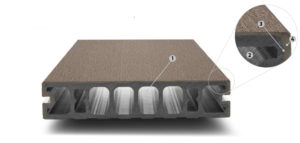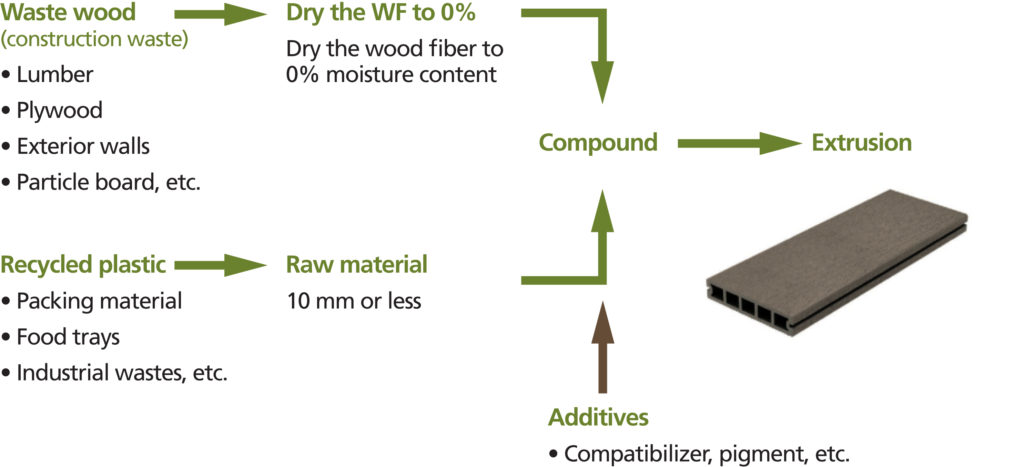
Geolam® Technology
Geolam® technology, developed 30 years ago in Japan, is a patented process and product technology.
One of the biggest obstacles in manufacturing wood-plastic composite is removing moisture from the wood fibers. Wood and petroleum-based thermoplastics, i.e. oil and water, do not adhere to one another naturally. Many wood-plastic composite manufacturers dry their wood flour to 0.5% to 3.0% moisture content. The effect of this is that the two materials do not bond in the extruder; rather they co-exist in the final product. In addition, wood acid can be created from this moisture leading to a product that is structurally weaker and less durable.
Watch Video on the manufacturing of our hybrid products
Process flow of Geolam® manufacturing
We reduce the moisture content of the wood fibers used to 0%
Geolam® technology embraces a patented process in which wood fibers are added to a high intensity mixer. The fibers are dried through a friction process incorporating a special mixer blade design. Once all moisture has been driven out of the wood, a thermoplastic is added along with a special reinforcing agent. The plastic is then literally beaten into the cells or tracheids of the wood, this being only possible because the wood contains no moisture. This creates an entirely new material, neither wood nor plastic, rather a fully integrated composite. This is why Geolam® is physically stronger and more stable in terms of its dimensions than any other wood-fiber composite product. Furthermore, since the wood actually surrounds the plastic, the finished product looks and feels like natural wood. This natural wood-like look and feel is also made possible because of the high wood content of the compound. Wood fibers are mixed with thermoplastics at an 8:1 volume ratio of wood to plastic (52% wood / 30% polypropylene and 18% other e.g. stabilizers, pigment, etc. by weight). Since the majority of the compound is wood, the product naturally takes on the characteristics of hardwood.
Hybrid Technology
As the first and only provider, Geolam offered its Wood Hybrid Systems (WHS) for facades, decks and roofs to the global marketplace in 2012. These WHS profiles are the result of an innovative hybrid technology, which enables heterogeneous materials to be successfully extruded together under heat.
Three layers of different materials undergo our patented triple extrusion process. Light, stable aluminum makes up the core. The connecting intermediate layer is made of a copolymer resin. The protective layer, lends the profiles the characteristics of tropical wood. This innovative combination of materials gives our profiles exceptionally superior features. They are three times lighter, four times more stable and eight times more rigid than WPC profiles. In addition, one single Geolam WHS profile can be bent to different radii and in different directions.
Wood, on the other hand, has to be bent in the direction of the fiber only.

1. RECYCLED ALUMINUM (6063T5)
As the core of the material, aluminum gives lightness and stability. The light metal allows safe and grid-free mounting options, which significantly expands the span between 2 points of attachment.
2. COPOLYMER RESIN
In the triple extrusion process, the intermediate layer of copolymer resin inseparably merges the aluminum core with the outer layer. This resin is very strong and so firmly connected to the two materials that the hybrid profiles can be bent into different radii (smallest radius: 400 mm or 16 in).
3. OUTER SKIN
The outer layer in WPC is available in many colors, but especially in different facing structures, too. The expansion of this hybrid material happens only in a very controlled way, even under extreme temperatures.
Hollow Cell Technology
Within the construction industry, Geolam’s invention of the original WPC as an alternative to tropical hardwood is considered a once-in-a-century innovation. And the innovation continues. First generation Geolam products were heavy, solid decking products. But in 1992 a production method developed by Japanese engineers led to the manufacture of the world’s first hollow
cell profiles and their typical honeycomb structure. Hollow cell boards are lighter, more efficient and absorb much less water than solid decking products used before 1992. Their cross sections can be selected to permit substantially larger spacing between joists in the substructure. The stability and ease of assembly provides, for this second generation, profiles which enable fast installation in larger properties and public sector construction projects.

1. HOLLOW CELL TECHNOLOGY
Hollow cell profiles allow implementation at reduced costs due to increase of profiles inertia.
2. HIGH-QUALITY EXTRUSION
Polished surfaces are synonymous with high extrusion quality.
3. CO-EXTRUSION
Combining the core and the external layer: the material is practically homogeneous, which makes it more resistant and more stable. Even on the cut planes, water cannot penetrate between the core and the external layer.
4. EXTERNAL LAYER (WPC)
The surface of the wood composite is available in several colors, but also with different surface structures. This allows the product to be adapted to various needs. The external layer can be designed so as to have flame retardant, anti-static or stain-resistant properties.





